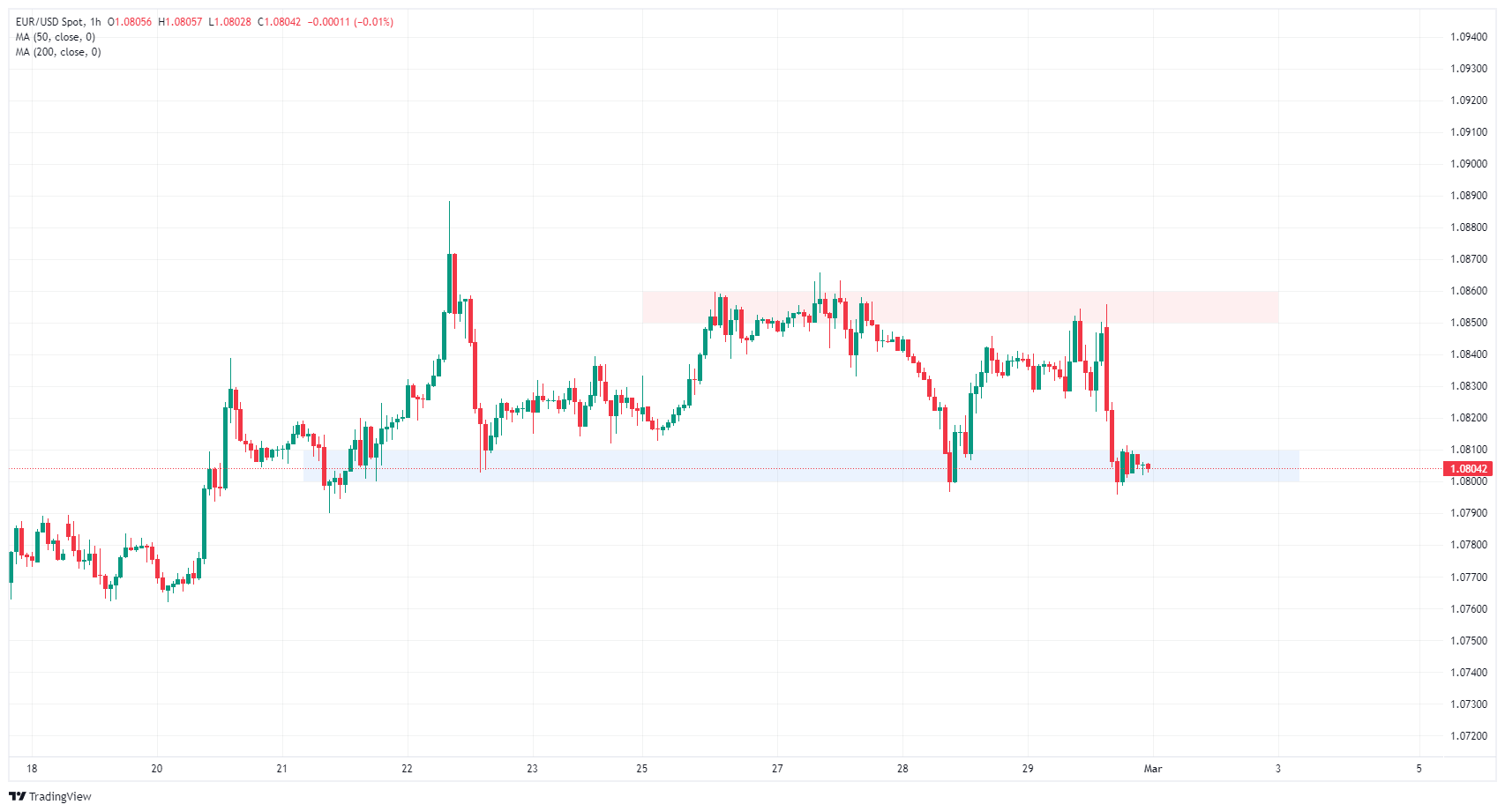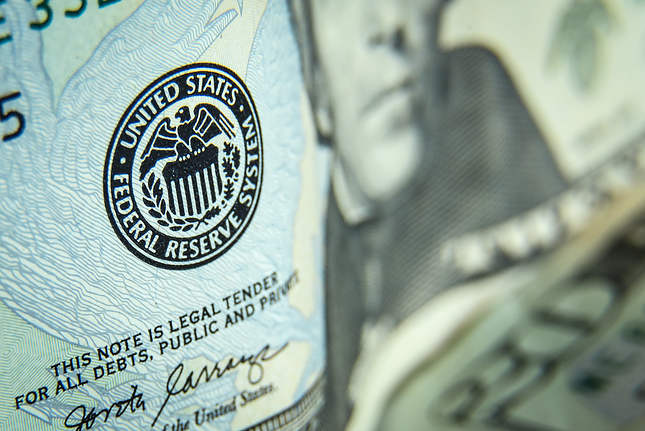Most recent article: EUR/USD rebounds into range on Friday after US ISM PMI miss sparks risk-on Friday
- EUR/USD knocked back into 1.0800 again on Thursday.
- German Retail Sales, CPI showed economic weakness.
- US PCE inflation came in as expected, lower than the prior month
EUR/USD drifted back into the 1.0800 handle once again on Thursday after weak-kneed German Retail Sales and Consumer Price Index (CPI) inflation came in mixed but missed the mark overall. The US Personal Consumption Expenditure Price Index (PCE) printed at median market forecasts, but investor confidence still wavered as US inflation remains too high for the Federal Reserve (Fed) to rush into rate cuts.
Friday will bring pan-European Harmonized Index of Consumer Prices (HICP) inflation for February, and February’s US ISM Manufacturing will round out the trading week. European HICP inflation is forecast to tick lower for the year ended February, and the US ISM Manufacturing PMI is expected to recover slightly but remain in contraction territory.
Daily digest market movers: EUR/USD backslides on US PCE inflation non-starter
- German YoY Retail Sales in January came in at -1.4%, falling less than the forecast of -1.5% but still a slight recovery from the previous -1.7%.
- MoM German Retail Sales missed the mark, printing at -0.4% versus the forecast of 0.5%. The previous month saw a -1.6% print.
- Germany’s YoY CPI for February saw 2.5% versus the forecast of 2.6%, down from the previous 2.9%.
- US Core PCE for the year through January printed at market expectations, coming in at the forecast of 2.4% versus the previous 2.6%.
- The Fed’s favored inflation indicator eased back in-line with model forecasts, but the figure still remains above the US central bank’s inflation target, eating away at investor hopes for a near-term Fed rate cut.
- According to the CME FedWatch Tool, money markets see nearly 80% chance of no rate cut in May, and a 35% chance of another rate hold in June.
Euro price this week
The table below shows the percentage change of Euro (EUR) against listed major currencies this week. Euro was the weakest against the Japanese Yen.
| USD | EUR | GBP | CAD | AUD | JPY | NZD | CHF | |
| USD | 0.15% | 0.38% | 0.53% | 1.00% | -0.23% | 1.60% | 0.38% | |
| EUR | -0.14% | 0.24% | 0.39% | 0.85% | -0.40% | 1.46% | 0.23% | |
| GBP | -0.38% | -0.23% | 0.15% | 0.62% | -0.64% | 1.22% | 0.01% | |
| CAD | -0.52% | -0.38% | -0.15% | 0.48% | -0.79% | 1.09% | -0.15% | |
| AUD | -1.02% | -0.86% | -0.62% | -0.47% | -1.26% | 0.61% | -0.63% | |
| JPY | 0.25% | 0.39% | 0.65% | 0.77% | 1.24% | 1.85% | 0.60% | |
| NZD | -1.63% | -1.49% | -1.24% | -1.08% | -0.61% | -1.88% | -1.25% | |
| CHF | -0.38% | -0.23% | 0.01% | 0.16% | 0.63% | -0.61% | 1.23% |
The heat map shows percentage changes of major currencies against each other. The base currency is picked from the left column, while the quote currency is picked from the top row. For example, if you pick the Euro from the left column and move along the horizontal line to the Japanese Yen, the percentage change displayed in the box will represent EUR (base)/JPY (quote).
Technical analysis: EUR/USD drops back to familiar technical support at 1.0800 on Thursday
EUR/USD slid back into the 1.0800 handle on Thursday, declining a little over half a percent top-to-bottom from the day’s high at 1.0856. The pair has struggled to find topside momentum since climbing over 1.0800 on February 20.
EUR/USD remains trapped between a supply zone near 1.0860 and a heavy demand zone above 1.0800. Near-term technicals are leaning into a bullish recovery if selling pressure fails to crack 1.0800.
EUR/USD remains mired on the 200-day Simple Moving Average (SMA) at 1.0828, and Thursday’s decline sets the pair up for a steeper downside rejection. The pair has struggled at the key long-term moving average since rising from the last swing low into the 1.0700 handle.
EUR/USD hourly chart
EUR/USD daily chart
Euro FAQs
What is the Euro?
The Euro is the currency for the 20 European Union countries that belong to the Eurozone. It is the second most heavily traded currency in the world behind the US Dollar. In 2022, it accounted for 31% of all foreign exchange transactions, with an average daily turnover of over $2.2 trillion a day.
EUR/USD is the most heavily traded currency pair in the world, accounting for an estimated 30% off all transactions, followed by EUR/JPY (4%), EUR/GBP (3%) and EUR/AUD (2%).
What is the ECB and how does it impact the Euro?
The European Central Bank (ECB) in Frankfurt, Germany, is the reserve bank for the Eurozone. The ECB sets interest rates and manages monetary policy.
The ECB’s primary mandate is to maintain price stability, which means either controlling inflation or stimulating growth. Its primary tool is the raising or lowering of interest rates. Relatively high interest rates – or the expectation of higher rates – will usually benefit the Euro and vice versa.
The ECB Governing Council makes monetary policy decisions at meetings held eight times a year. Decisions are made by heads of the Eurozone national banks and six permanent members, including the President of the ECB, Christine Lagarde.
How does inflation data impact the value of the Euro?
Eurozone inflation data, measured by the Harmonized Index of Consumer Prices (HICP), is an important econometric for the Euro. If inflation rises more than expected, especially if above the ECB’s 2% target, it obliges the ECB to raise interest rates to bring it back under control.
Relatively high interest rates compared to its counterparts will usually benefit the Euro, as it makes the region more attractive as a place for global investors to park their money.
How does economic data influence the value of the Euro?
Data releases gauge the health of the economy and can impact on the Euro. Indicators such as GDP, Manufacturing and Services PMIs, employment, and consumer sentiment surveys can all influence the direction of the single currency.
A strong economy is good for the Euro. Not only does it attract more foreign investment but it may encourage the ECB to put up interest rates, which will directly strengthen the Euro. Otherwise, if economic data is weak, the Euro is likely to fall.
Economic data for the four largest economies in the euro area (Germany, France, Italy and Spain) are especially significant, as they account for 75% of the Eurozone’s economy.
How does the Trade Balance impact the Euro?
Another significant data release for the Euro is the Trade Balance. This indicator measures the difference between what a country earns from its exports and what it spends on imports over a given period.
If a country produces highly sought after exports then its currency will gain in value purely from the extra demand created from foreign buyers seeking to purchase these goods. Therefore, a positive net Trade Balance strengthens a currency and vice versa for a negative balance.
Information on these pages contains forward-looking statements that involve risks and uncertainties. Markets and instruments profiled on this page are for informational purposes only and should not in any way come across as a recommendation to buy or sell in these assets. You should do your own thorough research before making any investment decisions. FXStreet does not in any way guarantee that this information is free from mistakes, errors, or material misstatements. It also does not guarantee that this information is of a timely nature. Investing in Open Markets involves a great deal of risk, including the loss of all or a portion of your investment, as well as emotional distress. All risks, losses and costs associated with investing, including total loss of principal, are your responsibility. The views and opinions expressed in this article are those of the authors and do not necessarily reflect the official policy or position of FXStreet nor its advertisers. The author will not be held responsible for information that is found at the end of links posted on this page.
If not otherwise explicitly mentioned in the body of the article, at the time of writing, the author has no position in any stock mentioned in this article and no business relationship with any company mentioned. The author has not received compensation for writing this article, other than from FXStreet.
FXStreet and the author do not provide personalized recommendations. The author makes no representations as to the accuracy, completeness, or suitability of this information. FXStreet and the author will not be liable for any errors, omissions or any losses, injuries or damages arising from this information and its display or use. Errors and omissions excepted.
The author and FXStreet are not registered investment advisors and nothing in this article is intended to be investment advice.
Recommended content
Editors’ Picks

AUD/USD holds steady near 0.6250 ahead of RBA Minutes
The AUD/USD pair trades on a flat note around 0.6250 during the early Asian session on Monday. Traders brace for the Reserve Bank of Australia Minutes released on Tuesday for some insight into the interest rate outlook.

USD/JPY consolidates around 156.50 area; bullish bias remains
USD/JPY holds steady around the mid-156.00s at the start of a new week and for now, seems to have stalled a modest pullback from the 158.00 neighborhood, or over a five-month top touched on Friday. Doubts over when the BoJ could hike rates again and a positive risk tone undermine the safe-haven JPY.

Gold price bulls seem non-committed around $2,620 amid mixed cues
Gold price struggles to capitalize on last week's goodish bounce from a one-month low and oscillates in a range during the Asian session on Monday. Geopolitical risks and trade war fears support the safe-haven XAU/USD. Meanwhile, the Fed's hawkish shift acts as a tailwind for the elevated US bond yields and a bullish USD, capping the non-yielding yellow metal.

Week ahead: No festive cheer for the markets after hawkish Fed
US and Japanese data in focus as markets wind down for Christmas. Gold and stocks bruised by Fed, but can the US dollar extend its gains? Risk of volatility amid thin trading and Treasury auctions.

Bank of England stays on hold, but a dovish front is building
Bank of England rates were maintained at 4.75% today, in line with expectations. However, the 6-3 vote split sent a moderately dovish signal to markets, prompting some dovish repricing and a weaker pound. We remain more dovish than market pricing for 2025.

Best Forex Brokers with Low Spreads
VERIFIED Low spreads are crucial for reducing trading costs. Explore top Forex brokers offering competitive spreads and high leverage. Compare options for EUR/USD, GBP/USD, USD/JPY, and Gold.